Ijraset Journal For Research in Applied Science and Engineering Technology
- Home / Ijraset
- On This Page
- Abstract
- Introduction
- Conclusion
- References
- Copyright
Design and Implementation of Electric Vehicle Technology by Using ANN Controller
Authors: K. Purushotham, N. Visali Madam
DOI Link: https://doi.org/10.22214/ijraset.2022.40065
Certificate: View Certificate
Abstract
It is possible to utilise EVs as both a load and provider of energy using the Vehicle-to-Grid (V2G) approach (or Grid-to-Vehicle technique if EVs are used as a load). With this technology, industrial microgrids may have voltage and power flow regulation and congestion management. An no of electric vehicles with a variety of charging profiles, battery states of charge and electric vehicle counts may benefit from two separate controllers (grid regulation and charger controller), according to the controllers, It is possible to regulate the main power flow and voltage drop in an industrial microgrid by allowing bidirectional power flow. Simulations indicate that the suggested controllers can regulate an industrial microgrid\'s voltage levels and power flow. According to industrial microgrids include solar, wind farms, electric car fleets, industrial loads, commercial loads, and a diesel generator. MATLAB/SIMULINK is used to simulate and analyze the results.
Introduction
I. INTRODUCTION
As the world's population continues to expand, so does the need for energy. Fossil fuels have been the dominant source of energy for a long time. There is still a shortage of these fuels across the globe despite this. As a result, the value of these resources changes greatly depending on how much of them are used. As a consequence of global geopolitical conflicts, many nations' energy sources face a long-term risk. Environmentally harmful emissions may also be caused by the usage of fossil fuels for electricity production. Future power systems will need to include renewable energy sources. However, RES fluctuations make it difficult to maintain a balance between supply and demand. With the goal of meeting expanding energy needs while reducing emissions, microgrids and electric cars were added to the mix of renewable energy sources. At the beginning of their lifespan, electric cars (EVs) have a notion that they are more costly to purchase than their gasoline-powered counterparts. Additionally, EVA's operations plans have been updated to include renewable energy. Electric vehicle replacements are expected to rise as a result of rising energy and climate change concerns [4]. Electric cars (EVs) are seen to be new energy vehicles because of their greater efficiency and performance. In the wake of these breakthroughs, novel industrial micro grids including electric vehicles (EVs) have emerged. We're on the verge of a paradigm shift in the transportation business thanks to electric and hybrid vehicles (HEVs). Electric utilities, on the other hand, will be affected by the widespread adoption of electric vehicles and hydrogen-powered vehicles (PHEVs). Managing the charging and discharging of large numbers of dispersed batteries is critical to the success of EVs and HEVs. Industrial microgrids and electric vehicles (EVs) may now be combined in novel ways thanks to these innovations. IMGs and EVs may benefit from the vehicle-to-grid (V2G) idea, which has been a key research topic. There has been little success with novel V2G control algorithms that focus the regulation of EV power output based on frequency variations, as well as not considering EV energy demands while trying to attain the estimated state of charge (SOC). Using grid regulation and charger controllers, this research focuses on developing a precise charging method. While a charger controller manages charging, a grid regulation controller regulates frequency in the event of a disruption in an industrial microgrid. In addition to providing voltage and frequency support for industrial microgrids throughout the day, charging stations are constructed in a manner that allows EV batteries to be regulated while they are connected to the industrial microgrid. Numerous writers in their research have clearly identified frequency control as a control approach and have offered several suggestions for its implementation. Wind turbine, battery storage, neural network and sliding mode controller are all employed to modulate the MG power and voltage drop. However, neural networks are great language expressions for small issues that do not need a high level of accuracy. The V2G technique immediately warns grid management in the event of a frequency disruption. A V2G and charging/discharging station management system based on grid operator frequency modulation signals The percentage estimate of the EV's profile state decides whether it is charging or regulated (discharging). Based on SOC, a variety of EV charging profiles are examined. The main powerflow and voltage drop of an industrial microgrid is controlled by controllers.
II. MODEL OF MG

A. Diesel Generator
One of the most prevalent forms of distributed generator (DG) is the diesel generator, which may provide anywhere from 1 kW to many tens of megawatts of electricity. Because of its dependability and effectiveness, it is frequently used. As a result, it may give a rapid dynamic reaction to disturbance rejection, which is particularly beneficial for unexpected changes in demand. When it comes to electricity costs and CO2 emissions, diesel generators are among the worst. Because of its rotating inertia, DG is able to swiftly adjust to MG's frequency shift. The DG's normal capacity was 0.95. There is a range in DG's output between zero and its rated output. Specified parameters of the device.

The diesel generator system's nominal power is 15MW, with a voltage of 25kV and a frequency of 50Hz. In the event of a failure of the microgrid, the diesel generator is called upon to keep the lights on. When linked to the grid, the rotor speed of a diesel generator equals the amount of electricity supplied and the amount of load demanded.The simulation Diagram of Diesel generator is as shown in Fig below.
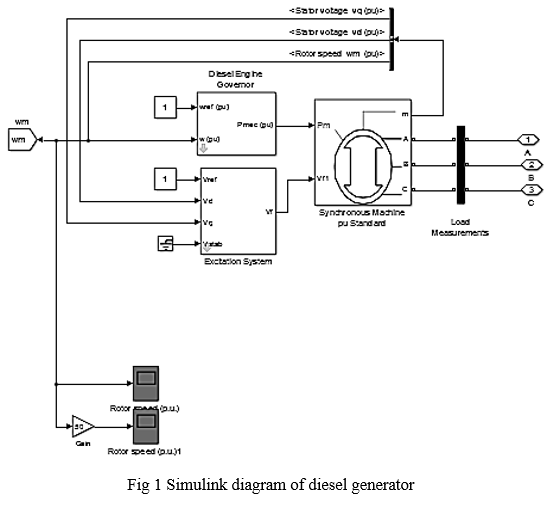
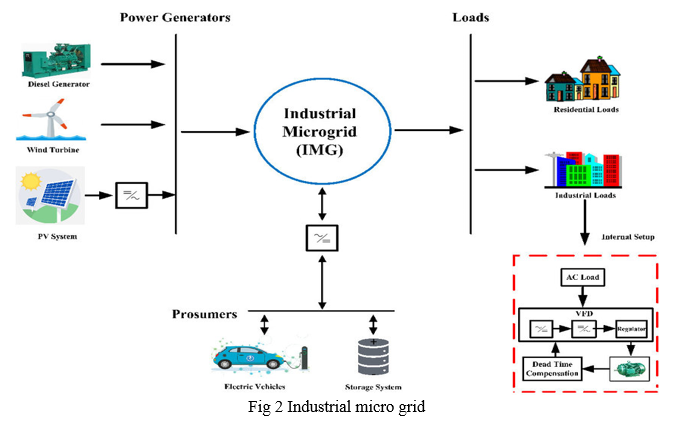
B. PV Systems
Zero to full power may be generated by a PV system. Sunlight or irradiance of solar is exclusively responsible for the device's output power. PV generation's restrictions are as follows:
Wgere,
PPV = Photovoltaic Power
PRPV =Rated Photovoltaic Power
C. Wind System
Wind farms are booming in popularity due to the clean, green energy they produce. The power grid has undergone significant transformation as a result of the inclusion of wind power. Wind power is unreliable when compared to other RES sources. Wind, in contrast to PV, is always accessible, however the intermittent nature of wind turbine output power poses concerns since wind curtailment is reliant on turbine output power. The wind's power output can only go as high as its rated power rating is given in Eqn 4

Where,
PW = Wind Power
PRW =Rated Wind Power
The mechanical power output of the wind turbine is given below. while the rated electrical power is obtained by multiplying Betz constant with Pmech is as follows,

D. EVs
As a load, a generator, and a mobile energy storage unit, EVs may perform several functions (MES). EV batteries, as opposed to traditional generators, can rapidly and effectively restore the system's frequency. To account for the linear behaviour of batteries in this area, the lower and higher SOC limits are set at 20% and 80%. The following are the restrictions:

One or more local networks, either wired or wireless, link every microgrid component together. Electric cars and distributed energy resources are shown in Fig. The restrictions and advantages of each component were considered throughout the design process:
- Initially, microgrids and EVs operate in an islanded mode, with PV and wind powering the community load while EVs charge.
- When the PV system can't supply the load, the clean diesel generator can.
- If the PV fails to supply the load and the diesel generator runs out of fuel, but the EVs are charged, the EVs can step in and supply the load.
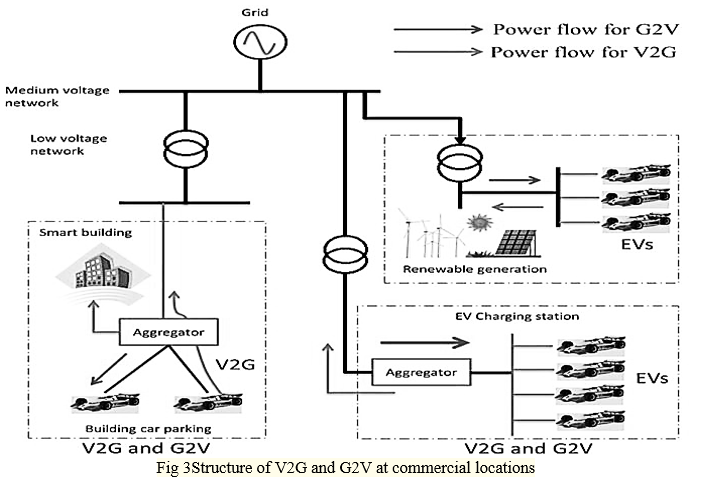
a. Grid Power from Electric Vehicles: From The Fig 4 The SOC (Status of Charge) of electric cars was maintained and their energy levels were changed while charging. These two levels should thus be considered the SOC level. Electric vehicles may be effectively used in primary frequency control (PFC) processes in such cases, according to the suggested coordination technique. The battery's SOC level was therefore maintained in the manner outlined by the SOC level, as was previously stated.
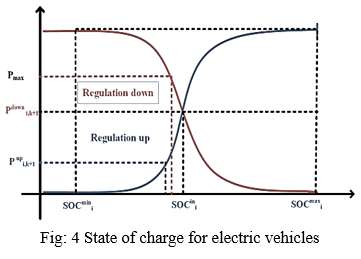


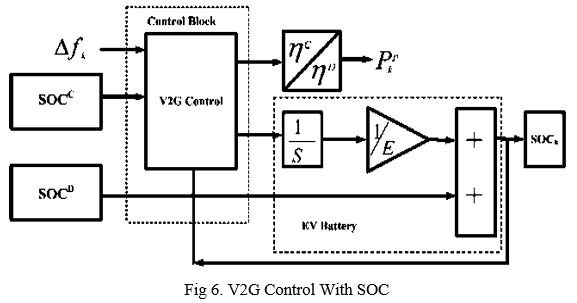
The Electric Vehicles Operator (EVsO) will receive signals from MGO to charge and discharge EVs. If Δf is positive, EVsO will start charging all EVs with SOC less than or equal to SOCmin and stop discharging EVs. If all charging EVs reach SOCmax, EVsO will charge all discharging EVs. When Δf is negative, the EVsO will start discharging all EVs with a SOC greater than SOC, and stop charging all EVs to counteract the effect of Δf. The Layout of State of charge controller is given below in fig7.
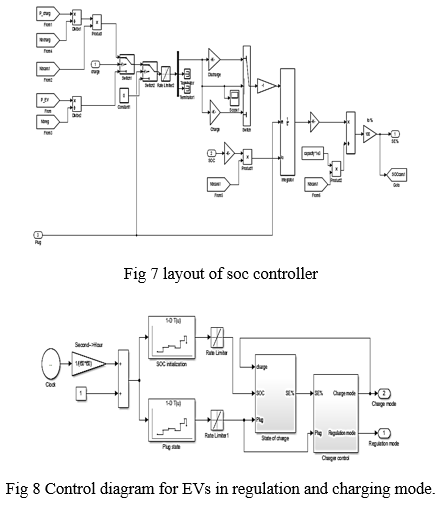
b. Grid Regulation Power Generation Controller (GRPGC): From the electric Vehicle charging and discharging mode shown in fig 8.It functions as an aggregater because of this V2G approach. The batteries of electric vehicles (EVs) are charged or discharged by an industrial microgrid operator (IMGO), who connects with a regulated current source. IMG's reactive power supply interacts with GRPGC through a GRC signal, which is generated by the GRPGC for the IMG's reactive power requirement. For forecasting and scheduling charging and discharging, grid regulation controllers interface with IMGO. In addition, it gives EV charging profiles for the region/area. With IMGO and electric vehicles, GRPGC works with the battery and the amount of power available to arrange charging and V2G activities.
III. PROPOSED CONTROLLERS
In this paper for Voltage drop and power flow regulation SMC-ANN is proposed
A. Slide Mode Controller
The controller forces system states to follow desired values, ensuring system stability in uncertain situations. Sliding mode controllers are used to keep tabs on the voltages in microgrids that use distributed energy. This strategy's goal is to exit the voltage chatter.
The voltages in the power system vary due to load variations.Slide mode controller are designed in MATLAB is shown in fig below.
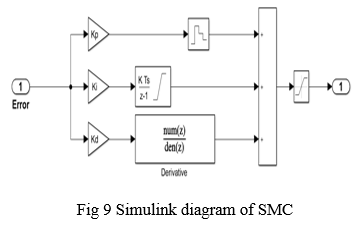
B. Artificial Neural Network
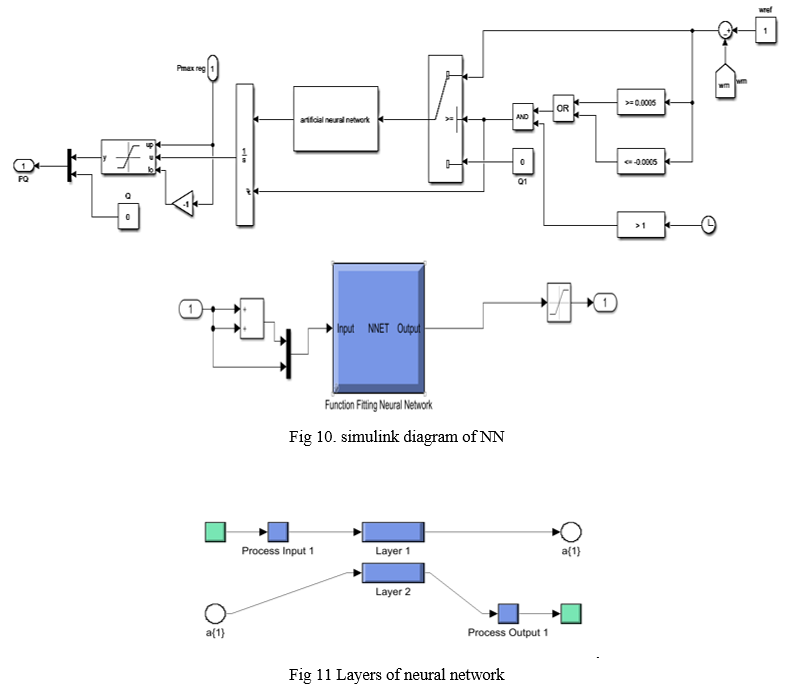
From the Fig 10 And 11 ,In The neural network there are three layers: the input, the hidden and the output. The number of system inputs and outputs determines the number of input/output layers. There are several ways to determine the number of hidden layers in a neural network. Linearity and log-sigmoidality characterise the output and hidden layer transfer functions, respectively The hidden layer employs a log-sigmoid function, whereas the output layer employs a linear function. In a layer, there is a concealed and an exposed layer. The transfer functions are calculated using the weight matrices W1 and Wz.
- Simulation Analysis and Results
Table1: parameters of devices in MG :
|
Parameters |
values |
|
PV FARM |
8MW |
|
WIND FARM |
4.5MW |
|
DIESEL GENERATOR |
15MW |
|
LOAD RESISDENTIAL |
10MW |
|
V2G |
4MW |
|
ASM |
0.16MVA |
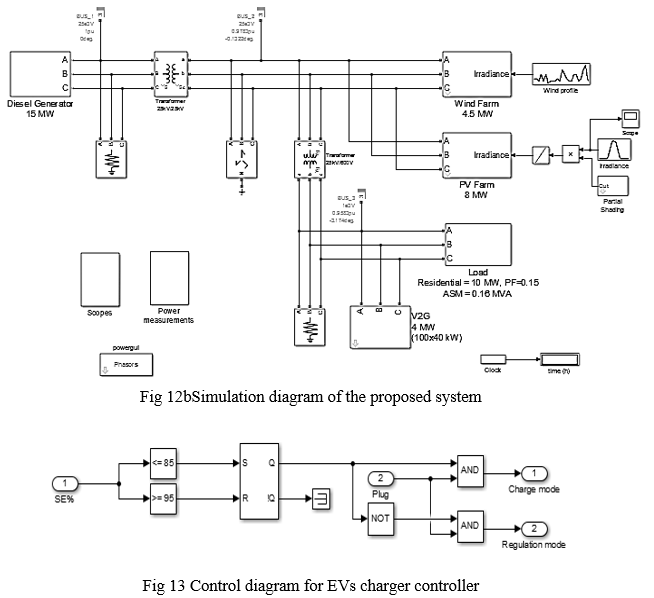
An buck-boost DC-DC converter is used in the charging station. AC is converted to DC via the rectifier. Afterward, the DC converter raises the voltage output. In this charging approach, electricity is supplied and used in both directions at the same time. At lunchtime, a solar farm mimics overcast weather by tripping its generators. Faster than the speed of sound at 13.5 metres per second. At a speed of 15 m/s, the wind farm will automatically shut down and re-start. Late night wind farm tours (22 hours). There is a 15MW diesel generator system with a 25kV and 50Hz nominal power output. When the microgrid goes down, the diesel generator steps in to fill up the void. A diesel generator's rotor speed equals supply and demand when linked to the grid.
2. Using Slide Mode Control
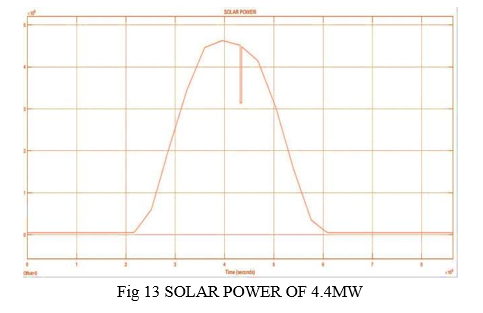

3. Using ANN

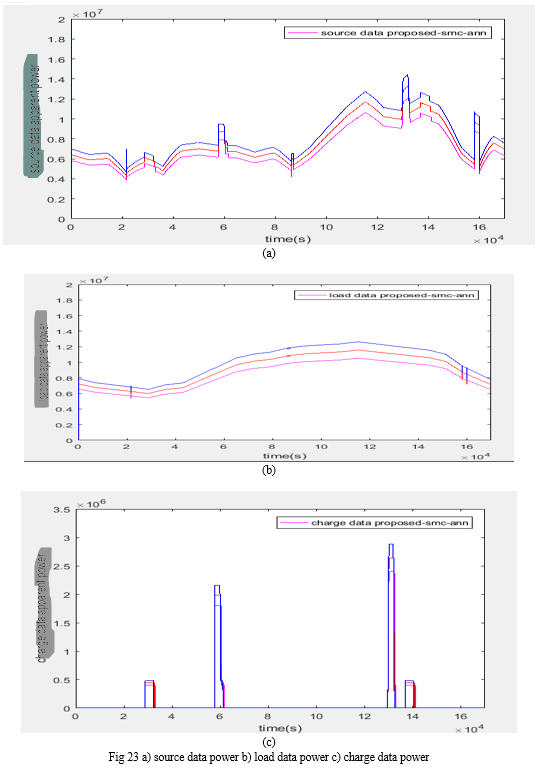

From the above data ELECTRIC VEHICLES V2G or G2V for power flow and votage drop at charge controller side. ANN controller is advantagable than SMC.
Conclusion
The impact of EV charging on an industrial microgrid is examined. The control scheme uses charger controllers and grid regulation to provide bidirectional power This dual power flow not only charges EVs but also regulates Voltage drop And Injecting power into an industrial micro-grid while improving power flow is the charging station\'s main function. The impact of various contingencies on primary frequency has been studied. The simulation results show that the proposed bidirectional charging strategy helps regulate voltage and powerflow. When charging/discharging EVs in V2G mode, the powerflow is well regulated within the acceptable margin. Increasing the number of EVs in the fleet improves voltage and power flow in the regulation. Thus, simulation results validate the proposed controllers.
References
[1] SHEERAZ IQBAL 1,2, XIN 1, MISHKAT ULLAH JAN 1, MOHAMED ABDELKARIM ABDELBAKY 1,3, HASEEB UR REHMAN 1, SALMAN SALMAN 1, SYED ASAD ABBAS RIZVI 1, AND MUHAMMAD AURANGZEB Aggregation of EVs for Primary Frequency Control of an Industrial Microgrid by Implementing Grid Regulation & Charger Controller . [2] Nykvist, B.; Sprei, F.; Nilsson, M. Assessing the progress toward lower priced long range battery electric vehicles. Energy Policy 2019, 124, 144–155. [3] Li, H.; Eseye, A.T.; Zhang, J.; Zheng, D. Optimal energy management for industrial microgrids with high-penetration renewables. Prot. Control Mod. Power Syst. 2017, 2, 12. [4] Li, Y.; Feng, B.; Li, G.; Qi, J.; Zhao, D.; Mu, Y. Optimal distributed generation planning in active distribution networks considering integration of energy storage. Appl. Energy 2018, 210, 1073–1081. [5] Liu, H.; Hu, Z.; Song, Y.;Wang, J.; Xie, X. Vehicle-to-grid control for supplementary frequency regulation considering charging demands. IEEE Trans. Power Syst. 2014, 30, 3110–3119. [6] Bayati, M.; Abedi, M.; Gharehpetian, G.B.; Farahmandrad, M. Short-term interaction between electric vehicles and microgrid in decentralized vehicle-to-grid control methods. Prot. Control Mod. Power Syst. 2019, 4, 1–11. [7] Shafie-khah, M.; Siano, P.; Aghaei, J.; Masoum, M.A.; Li, F.; Catalão, J.P. Comprehensive review of the recent advances in industrial and commercial DR. IEEE Trans. Power Syst. 2019, 15, 3757–3771. [8] Rizvi, S.A.A.; Xin, A.; Masood, A.; Iqbal, S.; Jan, M.U.; Rehman, H. Electric Vehicles and their Impacts on Integration into Power Grid: A Review. In Proceedings of the 2nd IEEE Conference on Energy Internet and Energy System Integration (EI2), Beijing, China, 20–22 October 2018; pp. 1–6. [9] Liu, H.; Huang, K.; Wang, N.; Qi, J.; Wu, Q.; Ma, S.; Li, C. Optimal dispatch for participation of electric vehicles in frequency regulation based on area control error and area regulation requirement. Appl. Energy 2019, 240, 46–55. [10] Meng, J.; Mu, Y.; Jia, H.; Wu, J.; Yu, X.; Qu, B. Dynamic frequency response from electric vehicles considering travelling behavior in the Great Britain power system. Appl. Energy 2016, 162, 966–979. [11] Zhang, Q.; Li, Y.; Li, C.; Li, C.-Y. Real-time adjustment of load frequency control based on controllable energy of electric vehicles. Trans. Inst. Meas. Control 2020, 42, 42–54. [12] Shakerighadi, B.; Anvari-Moghaddam, A.; Ebrahimzadeh, E.; Blaabjerg, F.; Bak, C.L. A hierarchical game theoretical approach for energy management of electric vehicles and charging stations in smart grids. IEEE Access 2018, 6, 67223–67234.
Copyright
Copyright © 2022 K. Purushotham, N. Visali Madam. This is an open access article distributed under the Creative Commons Attribution License, which permits unrestricted use, distribution, and reproduction in any medium, provided the original work is properly cited.

Download Paper
Paper Id : IJRASET40065
Publish Date : 2022-01-24
ISSN : 2321-9653
Publisher Name : IJRASET
DOI Link : Click Here
 Submit Paper Online
Submit Paper Online

